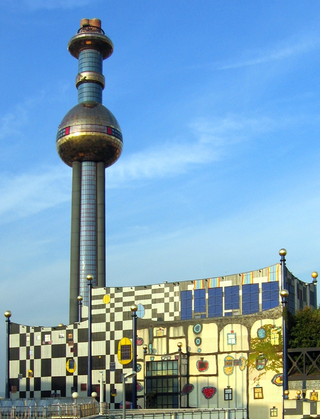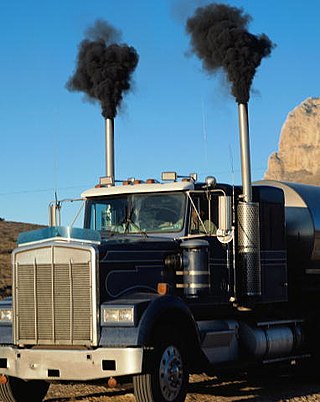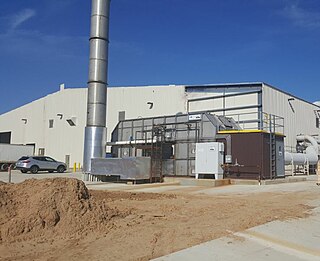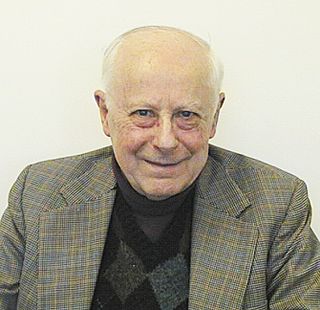
Incineration is a waste treatment process that involves the combustion of substances contained in waste materials. Industrial plants for waste incineration are commonly referred to as waste-to-energy facilities. Incineration and other high-temperature waste treatment systems are described as "thermal treatment". Incineration of waste materials converts the waste into ash, flue gas and heat. The ash is mostly formed by the inorganic constituents of the waste and may take the form of solid lumps or particulates carried by the flue gas. The flue gases must be cleaned of gaseous and particulate pollutants before they are dispersed into the atmosphere. In some cases, the heat that is generated by incineration can be used to generate electric power.

A catalytic converter is an exhaust emission control device which converts toxic gases and pollutants in exhaust gas from an internal combustion engine into less-toxic pollutants by catalyzing a redox reaction. Catalytic converters are usually used with internal combustion engines fueled by gasoline or diesel, including lean-burn engines, and sometimes on kerosene heaters and stoves.

Corning Incorporated is an American multinational technology company that specializes in specialty glass, ceramics, and related materials and technologies including advanced optics, primarily for industrial and scientific applications. The company was named Corning Glass Works until 1989. Corning divested its consumer product lines in 1998 by selling the Corning Consumer Products Company subsidiary to Borden.

CVCC, or Compound Vortex Controlled Combustion, is an internal combustion engine technology developed and trademarked by the Honda Motor Company.

Exhaust gas or flue gas is emitted as a result of the combustion of fuels such as natural gas, gasoline (petrol), diesel fuel, fuel oil, biodiesel blends, or coal. According to the type of engine, it is discharged into the atmosphere through an exhaust pipe, flue gas stack, or propelling nozzle. It often disperses downwind in a pattern called an exhaust plume.
An oxygen sensor (or lambda sensor, where lambda refers to air–fuel equivalence ratio, usually denoted by λ) or probe or sond, is an electronic device that measures the proportion of oxygen (O2) in the gas or liquid being analysed.
Lean-burn refers to the burning of fuel with an excess of air in an internal combustion engine. In lean-burn engines the air–fuel ratio may be as lean as 65:1. The air / fuel ratio needed to stoichiometrically combust gasoline, by contrast, is 14.64:1. The excess of air in a lean-burn engine emits far less hydrocarbons. High air–fuel ratios can also be used to reduce losses caused by other engine power management systems such as throttling losses.

An exhaust system is used to guide reaction exhaust gases away from a controlled combustion inside an engine or stove. The entire system conveys burnt gases from the engine and includes one or more exhaust pipes. Depending on the overall system design, the exhaust gas may flow through one or more of the following:
Candoluminescence is the light given off by certain materials at elevated temperatures that has an intensity at some wavelengths which can, through chemical action in flames, be higher than the blackbody emission expected from incandescence at the same temperature. The phenomenon is notable in certain transition-metal and rare-earth oxide materials (ceramics) such as zinc oxide, cerium(IV) oxide and thorium dioxide.

A diesel particulate filter (DPF) is a device designed to remove diesel particulate matter or soot from the exhaust gas of a diesel engine.
Stanley Donald Stookey was an American inventor. He had 60 patents in his name related to glass and ceramics, some patents solely his and others shared as joint patents with other inventors. His discoveries and inventions have contributed to the development of ceramics, eyeglasses, sunglasses, cookware, defense systems, and electronics.

A thermal oxidizer is a process unit for air pollution control in many chemical plants that decomposes hazardous gases at a high temperature and releases them into the atmosphere.

William C. Pfefferle was an American scientist and inventor.
Microlith is a brand of catalytic reactor invented by engineer William C. Pfefferle.
Vladimir Haensel was an American chemical engineer who invented the platforming process - a platinum catalytic process for reforming petroleum hydrocarbons into gasoline. In addition, he was influential in the creation of catalytic converters for automobiles.
Rodney D. Bagley was an engineer and co-inventor of the catalytic converter.
Carl Donald Keith was a chemist who was inventor of the three-way catalytic converter, which has played a dramatic role in reducing pollution from motor vehicles since their introduction in the mid-1970s.
John Joseph Mooney was an American chemical engineer who was co-inventor of the three-way catalytic converter, which has played a dramatic role in reducing pollution from motor vehicles since their introduction in the mid-1970s.
A Johnson thermoelectric energy converter or JTEC is a type of solid-state heat engine that uses the electrochemical oxidation and reduction of hydrogen in a two-cell, thermal cycle that approximates the Ericsson cycle. It is under investigation as a viable alternative to conventional thermoelectric conversion. Lonnie Johnson invented it and claims the converter exhibits an energy conversion efficiency of as much as 60%, however, this claim is at a theoretical level based on comparison with a Carnot cycle and assumes a temperature gradient of 600 °C. It was originally proposed for funding to the Office of Naval Research but was refused. Johnson obtained later funding by framing the engine as a hydrogen fuel cell. Johnson had been collaborating with PARC on development of the engine.
Pulsation reactor technology is a thermal procedure for manufacturing fine powders with precisely defined properties.









